RESEARCH
Estimating pregnancy-related mortality from census data:experience in Latin America
Estimation de la mortalité liée la grossesse d'après des données de recensement : expérience concernant l'Amérique latine
Estimación de la mortalidad relacionada con el embarazo a partir de datos del censo: experiencia en América Latina
Kenneth HillI,*; Bernardo L QueirozII; Laura WongII; Jorge PlataIII; Fabiana Del PopoloIV; Jimmy RosalesV; Cynthia StantonVI
IHarvard University, Cambridge, MA, United States of America (USA)
IICentro de Desenvolvimento e Planejamento Regional, Universidade Federal de Minas Gerais, Belo Horizonte, MG, Brazil
IIIInstituto Nacional de Estadística de Honduras, Tegucigalpa, Honduras
IVDivisión de Población de la Comisión Económica para América Latina y el Caribe, Santiago, Chile
VInstituto Nacional de Estadística y Censos de Nicaragua, Managua, Nicaragua
VIJohns Hopkins Bloomberg School of Public Health, Baltimore, MD, USA
ABSTRACT
OBJECTIVE: To assess the feasibility of measuring maternal mortality in countries lacking accurate birth and death registration through national population censuses by a detailed evaluation of such data for three Latin American countries.
METHODS: We used established demographic techniques, including the general growth balance method, to evaluate the completeness and coverage of the household death data obtained through population censuses. We also compared parity to cumulative fertility data to evaluate the coverage of recent household births. After evaluating the data and adjusting it as necessary, we calculated pregnancy-related mortality ratios (PRMRs) per 100 000 live births and used them to estimate maternal mortality.
FINDINGS: The PRMRs for Honduras (2001), Nicaragua (2005) and Paraguay (2002) were 168, 95 and 178 per 100 000 live births, respectively. Surprisingly, evaluation of the data for Nicaragua and Paraguay showed overreporting of adult deaths, so a downward adjustment of 20% to 30% was required. In Honduras, the number of adult female deaths required substantial upward adjustment. The number of live births needed minimal adjustment. The adjusted PRMR estimates are broadly consistent with existing estimates of maternal mortality from various data sources, though the comparison varies by source.
CONCLUSION: Census data can be used to measure pregnancy-related mortality as a proxy for maternal mortality in countries with poor death registration. However, because our data were obtained from countries with reasonably good statistical systems and literate populations, we cannot be certain the methods employed in the study will be equally useful in more challenging environments. Our data evaluation and adjustment methods worked, but with considerable uncertainty. Ways of quantifying this uncertainty are needed.
RÉSUMÉ
OBJECTIF: Estimer la faisabilité d'une mesure de la mortalité maternelle dans les pays ne disposant pas d'un enregistrement précis des naissances et des décès par le biais des recensements nationaux de la population, à travers une évaluation détaillée des données de recensement pour trois pays d'Amérique latine.
MÉTHODES: Nous avons utilisé des techniques démographiques établies, et notamment la méthode générale des équilibres de croissance, pour évaluer la complétude et la couverture des données relatives aux décès parmi les ménages obtenues par des recensements de la population. Nous avons également évalué la parité avec les données de fertilité cumulée pour estimer la couverture des données relatives aux naissances récentes parmi les ménages. Après évaluation et ajustement le cas échéant des données, nous avons calculé les taux de mortalité liée à la grossesse pour 100 000 naissances vivantes et nous les avons utilisés pour estimer la mortalité maternelle.
RÉSULTATS: Les taux de mortalité liée à la grossesse étaient respectivement de 168, 95 et 178 pour 100 000 naissances vivantes pour le Honduras (2001), le Nicaragua (2005) et le Paraguay (2002). L'évaluation des données pour le Nicaragua et le Paraguay a mis curieusement en évidence une surnotification des décès d'adultes, de sorte qu'un ajustement à la baisse de 20 à 30 % s'est avéré nécessaire. Au Honduras en revanche, le nombre de décès de femmes adultes a dû faire l'objet d'un ajustement substantiel à la hausse. L'ajustement à pratiquer sur le nombre de naissances vivantes était minimal. Les estimations ajustées des taux de mortalité liée à la grossesse étaient globalement cohérentes avec les estimations de la mortalité maternelle disponibles à partir de diverses sources de données, le résultat de la comparaison étant cependant très variable selon la source.
CONCLUSION: Les données de recensement sont utilisables pour mesurer la mortalité liée à la grossesse en tant qu'indicateur indirect de la mortalité maternelle dans les pays où l'enregistrement des décès est insuffisant. Cependant, nos données étant issues de pays dotés de systèmes statistiques raisonnablement efficaces et de populations sachant lire et écrire, nous ne pouvons être certains que les méthodes employées dans cette étude seront aussi utiles dans des environnements plus difficiles. Nos méthodes d'évaluation et d'ajustement des données ont fonctionné, mais avec une incertitude considérable. Il faudrait disposer de moyens pour quantifier cette incertitude.
RESUMEN
OBJETIVO: Determinar las posibilidades de medir adecuadamente la mortalidad materna en los países que carecen de registros precisos de nacimiento y defunción a través de los censos de población nacionales, procediendo para ello a evaluar los datos de ese tipo en tres países latinoamericanos.
MÉTODOS: Utilizamos técnicas demográficas consagradas, en particular el método de la distribución por edad de las muertes (growth balance), para evaluar la completud y cobertura de los datos sobre defunciones en el hogar obtenidos mediante los censos de población. Además, comparamos los datos sobre el número de partos y la fecundidad acumulada para evaluar la cobertura de nacimientos recientes en los hogares. Tras evaluar los datos y realizar los ajustes necesarios, calculamos las razones de mortalidad relacionada con el embarazo (RMRE) por 100 000 nacidos vivos, y a partir de ellas se estimó la mortalidad materna.
RESULTADOS: Las RMRE para Honduras (2001), Nicaragua (2005) y el Paraguay (2002) fueron de 168, 95 y 178 por 100 000 nacidos vivos, respectivamente. Sorprendentemente, al evaluar los datos correspondientes a Nicaragua y el Paraguay se detectó una sobrenotificación de defunciones de adultos, lo que obligó a realizar un ajuste a la baja del 20%-30%. En el caso de Honduras, fue necesario un ajuste al alza sustancial del número de defunciones de mujeres adultas. El número de nacidos vivos requirió sólo un ajuste mínimo. Las estimaciones ajustadas de la RMRE se corresponden en general con las estimaciones actuales de la mortalidad materna procedentes de diversas fuentes de datos, aunque hay diferencias según la fuente.
CONCLUSIÓN: Es posible utilizar datos del censo para medir la mortalidad relacionada con el embarazo como indicador sustitutivo de la mortalidad materna en los países con registros de defunción deficientes. Sin embargo, dado que nuestros datos se obtuvieron en países con sistemas estadísticos razonablemente buenos y una población alfabetizada, no podemos afirmar con seguridad que los métodos empleados en el estudio sean igualmente útiles en otros entornos más problemáticos. Nuestros métodos de evaluación y ajuste de los datos funcionaron, pero con una incertidumbre considerable. Se requieren métodos que permitan cuantificar esa incertidumbre.

Introduction
High maternal mortality in developing countries is considered a major public health problem. The issue is of high priority on the international community's public health agenda, as shown by the fact that reducing maternal mortality is the target of UN Millennium Development Goal 5.1 The difficulties in measuring maternal mortality have been amply documented elsewhere,2-4 and there is no consensus as to what method is best. The following factors should be considered in choosing a method: the completeness and quality of civil registration; the content and sample size of upcoming national population health surveys; the proportion of births taking place in health facilities; and the completeness and quality of routine health information systems. Recently, greater interest has been shown in using data from the population census to measure maternal mortality, and such use is likely to increase in the future as a result of the endorsement of this method by the United Nations Principles and Recommendations for Population and Housing Censuses.5
In attempts to achieve greater accuracy, in the 1980s methods were developed for evaluating and adjusting population census data on household deaths in a defined reference period.6-9 As a result, in the 1990 census round several countries included questions intended to ascertain if any women of reproductive age had died during pregnancy or within a defined period post-partum, usually 6 weeks. The purpose was to make it possible to estimate pregnancy-related mortality. Data from five of these censuses were analysed in 1999.10
The census-based methods that have been developed have several advantages. They yield a greater number of reported pregnancy-related deaths than sample surveys, which makes it possible to analyse differentials. Furthermore, they provide the necessary information for evaluating coverage. But they have disadvantages as well. The number of deaths reported is often biased (generally downwards). Because they are infrequent, censuses cannot be used for routine monitoring. Finally, census-based methods identify pregnancy-related deaths (all deaths occurring during pregnancy and up to 42 days after pregnancy ends), rather than maternal deaths (deaths occurring during pregnancy and up to 42 days after pregnancy ends from any cause related to or aggravated by the pregnancy or its management, but not from incidental causes)11. Therefore, pregnancy-related deaths overestimate true maternal deaths, though failure to report a death as pregnancy-related (as occurs, for example, with deaths from induced abortion) may in practice bring the numbers closer together.12,13
In the 2000 census round, a larger number of countries - Honduras, Nicaragua and Paraguay among them - included questions on the timing of household deaths in relation to pregnancy. This paper analyses the data from these three countries to draw lessons regarding the feasibility of using pregnancy-related deaths to assess maternal deaths. Throughout the paper we refer to "pregnancy-related deaths" when identified as such in the censuses; we do not call such deaths "maternal" (as is done in the Demographic and Health Surveys14 and the WHO global estimates of maternal mortality).15-18 In the discussion section we describe the relationship that probably exists between pregnancy-related deaths and maternal deaths.
This paper supplements the 1999 analysis in two ways: the countries included are in Latin America, a region not previously covered, and alternative data sources provide additional opportunities to evaluate the results.
Methods
To estimate the pregnancy-related mortality ratio (PRMR) from census figures, three types of data are needed: the number of deaths among women of reproductive age, the proportion of those deaths that are pregnancy-related, and the number of births in the period during which the deaths occurred. The estimation also calls for evaluation methods specific to each type of data. Data needs are: (i) age and sex distributions from two censuses separated by not more than 15 years; (ii) household deaths by age and sex for a defined time period before one or both of the censuses; (iii) for deaths of women of reproductive age, whether the woman was pregnant or within 6 weeks of the end of a pregnancy when she died; and (iv) information on births by age of mother in a defined time period before one or both of the censuses, together with information about the number of children ever born to each woman.
Table 1 describes the data obtained from the censuses in Honduras, Nicaragua and Paraguay. The question on household deaths in Honduras and Paraguay referred to deaths during the calendar year (January to December) before the census. Although the question clearly defined the reference period, it may have led to more recall error than a question on the deaths that occurred over the 12 months before the census. The question in Nicaragua referred to deaths between January 2004 and the date the census was conducted in 2005, a period of about 17 months. We used all the deaths in the analysis but adjusted the results by a ratio of 12:17 to correspond approximately to a 12-month period. The few cases for which information about sex or age at death was missing were distributed proportionately.
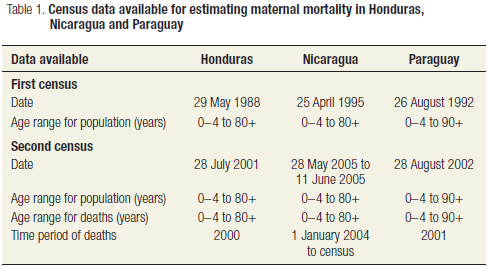
Coverage of female deaths
Several methods based on equations of population dynamics have been developed to evaluate how well reported deaths cover the population.6-8 In this study we used the general growth balance (GGB) method,8 derived from the demographic balancing equation, according to which the growth rate of the population equals the difference between its entry and exit rates.19 The method, described in detail elsewhere,20 compares the observed death (exit) rates for open-ended groups x years of age and over to residual estimates (entry rates minus growth rates) of the corresponding death rates derived from census age distributions alone. The method depends on having two census counts from which age-specific intercensal growth rates can be calculated. Key assumptions are that: (i) the population is closed to migration; (ii) the completeness of recording of the deaths is constant across ages; (iii) the completeness of recording of the population is constant across ages; and (iv) the ages of the living and dead are reported without error. It should be noted that the method compares the age distribution of the deaths (typically reported only at the second census) to the intercensal population change; thus, strictly speaking, it estimates the completeness of recording between censuses, not at the beginning or end of the intercensal period. To avoid distortions in age distribution, we estimated the average age distribution of intercensal deaths by first calculating age-specific mortality rates using the deaths by age and population by age from the second census, and then applying those rates to estimates of the intercensal age distribution (see the Discussion section for the consequences of this approach).
The assumption that the population is closed to migration is important for the three countries studied because each has experienced recent net emigration. The method uses information on deaths and growth rates for open-ended groups x years of age and over for a series of ages x. If there is some age x above which net migration is negligible, the performance of the method above that age will be unaffected.
Pregnancy-related deaths
No formal methods exist for evaluating the proportion of deaths reported to be pregnancy-related; one less formal way is to assess the plausibility of the pattern of the proportions of pregnancy-related deaths for women at different ages. Since the risk of dying in pregnancy or shortly after is related to the proportion of women who are pregnant during the reference period, pregnancy-related deaths should approximately follow the fertility pattern by age in the population.
Recorded births
Brass proposed a method6 for assessing the completeness of the recording of births by comparing cumulated age-specific fertility rates, equivalent to lifetime fertility for a synthetic cohort, to women's reports of lifetime fertility. As originally developed, the method was based on the assumption of constant fertility. When information on lifetime fertility is available for two or more time points, this assumption can be relaxed; cumulated current fertility can instead be compared to cumulated cohort parity increments from one census to the next.21,22 All three countries studied here included questions on children ever born in both censuses analysed, and they experienced substantial fertility change in recent decades. We therefore applied the intercensal method22 to evaluate the reporting of births.
Results
The performance of the method for evaluating the coverage of deaths is best portrayed graphically. Fig. 1, Fig. 2 and Fig. 3 plot the observed death rates for open-ended age groups x and over (x+) against the residual estimates for the same open-ended age groups; points are shown for values of x from 5 to 75 years for the female populations of Honduras, Nicaragua and Paraguay, respectively. The slope of the straight line fitted to the points estimates the adjustment factor needed to make the observed death rates consistent with the residual estimates of the death rate based on the recorded population, whereas the intercept provides an estimate of change in population coverage from one census to the next. Table 2 summarizes the parameters (intercept and slope) of the straight lines fitted by orthogonal regression to two sets of points: those for open-ended age groups 5+ to 75+ years and those for 35+ to 75+ years.
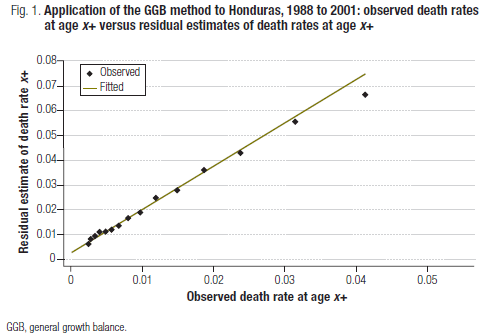
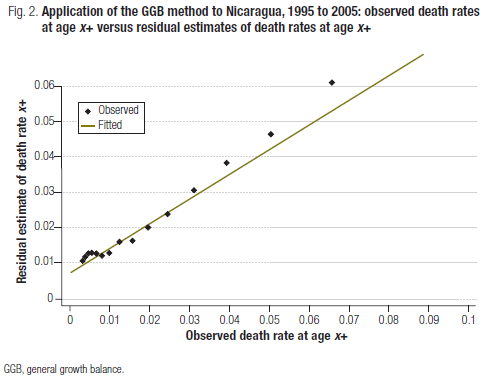
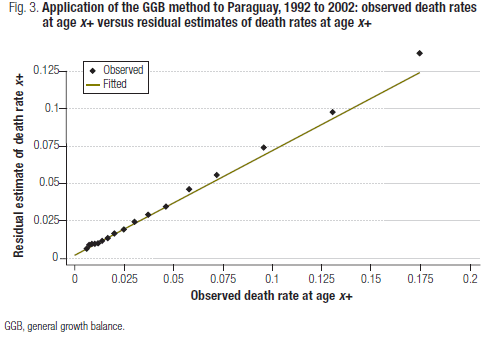

If the method's assumptions are met, the points for different open-ended age groups should all lie on a straight line. Fig. 1, Fig. 2 and Fig. 3 confirm the concern about net emigration: the points for all three countries are distinctly irregular at younger ages (the points close to the origin represent younger ages, in which death rates are lowest), and the intercepts are all greater than zero, indicating higher coverage in the first census than in the second, consistent with net intercensal emigration.
Fig. 1, Fig. 2 and Fig. 3 suggest, however, that the distortion resulting from migration is small above the age of 35 years. Therefore, we focused on the adjustment factors indicated by the points in this age range. The results are surprising. For Honduras, we estimated that deaths were underreported by about one-third. Underreporting is not unusual in census questions about household deaths, but it is rarely this high. For Nicaragua and Paraguay, we estimated deaths to be overreported by about 20% to 30% (even after adjusting deaths from the 2005 Nicaragua census to approximate a 12-month period). We have no explanation for this apparent overreporting of deaths in Nicaragua, unless perhaps some deaths among the substantial Nicaraguan population living in Costa Rica were reported. The census questions in Paraguay pertained to deaths in one calendar year (though the year in question, 2001, had ended around 8 months before the census date in July 2002). We explored the possibility that the question was misunderstood to refer to all deaths since the beginning of 2001, yet this seems unlikely since for January to July, the months that would have been duplicated, the number of deaths was not consistently excessive when compared with the number for August to December.
We used the slopes shown in Table 2, fitted to the open-ended age groups 35+ to 75+ years, to adjust the intercensal numbers of deaths of women 15-49 years of age. The mortality rates based on these adjusted numbers were used to calculate the probabilities of dying between ages 15 and 60 (45q15) (Table 2). These probabilities were then compared as a plausibility check to estimates prepared by the Economic Commission for Latin America and the Caribbean (CELADE)23 (not shown). The estimates for Honduras and Paraguay were fairly close, whereas our estimate of 45q15 for Nicaragua was 0.097, lower than the CELADE estimate of 0.169.
The observed proportions of deaths that were pregnancy-related (PDPRs) among adult females for Honduras, Nicaragua and Paraguay were 10.4%, 8.5% and 10.7%, respectively. As a plausibility check, the PDPR in each age group was compared to the proportion of births reported for that age group; if the risks of pregnancy-related death do not vary with age, the two patterns should be the same. These data are essentially independent and are collected in separate parts of the census questionnaires. Fig. 4 shows the ratio of the proportion of maternal deaths to the proportion of births for each age group from 15-19 and 45-49 years. These ratios are slightly below 1.0 up to the age of 30 years but rise steeply at older ages (particularly for Nicaragua). This pattern is plausible, since it is in accord with the widely-observed pattern of a relatively low risk of maternal death up to the age of 30 and a subsequent steep rise.24,25
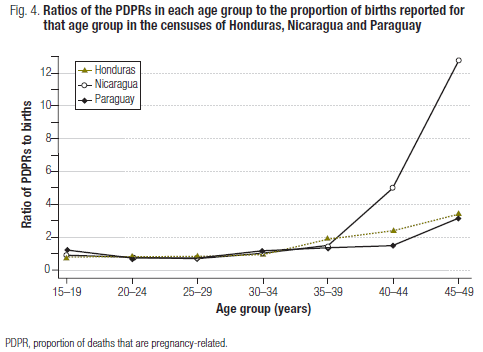
A second check is available in the case of Honduras, where reproductive age mortality surveys (RAMOS) that measured PDPR were conducted in both 1990 and 1997. According to the final report of the second survey, the PDPR dropped from 21% in 1990 to 12% in 1997.19,26 Thus, the census estimate of a PDPR of 10.4% for 2001 is consistent with the survey data, if one assumes a continued gradual decline after 1997.
Table 3 shows the plausibility checks for fertility in terms of the ratios of cumulated current to synthetic lifetime fertility. For Honduras, the ratios were remarkably close to 1 and varied little with age; minimal adjustment was required. For Paraguay, the ratios were fairly constant with age, especially after the age of 25 years, but they suggest the need for a slight upward adjustment of about 3% to recent fertility. For Nicaragua, the data are less satisfactory; women aged 40-44 years in 2005 reported fewer children ever born, on average, than the same cohort at ages 30-34 years in 1995, and the data also suggest some omissions by women in their thirties in 2005. As a result, the ratios are low above the age of 30; we focused on the ratios for women in their twenties, which suggested the need to adjust recent fertility downwards by approximately 2.5%.
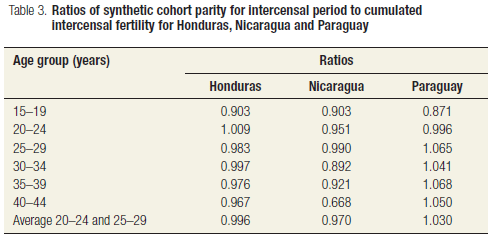
The PRMR is the number of pregnancy-related deaths (multiplied by 100 000) divided by the number of live births. To arrive at the final calculation for each country (Table 4), the number of deaths of women 15-49 years of age was adjusted for estimated coverage, multiplied by the (unadjusted) PDPR, and then divided by an adjusted number of live births. The PRMRs for Honduras and Paraguay were virtually the same - 168 and 178 per 100 000 live births, respectively - whereas Nicaragua was estimated to have the lowest value, 95 per 100 000 live births.
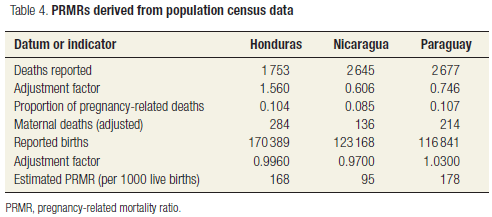
Discussion
This analysis has touched on several issues that merit further discussion, particularly since the methods employed are being promoted for use in the 2010 round of censuses.
The first issue is how well the method used to adjust the deaths reported in the censuses works. When applied to accurate data for developed countries, the method seems to work, on average, but with considerable uncertainty.26 This is a concern, given that deaths were adjusted upwards by a substantial amount in Honduras, but downwards in both Nicaragua and Paraguay. Further work to gauge the uncertainty surrounding these adjustment methods is needed. A further concern relates to the plausibility of the magnitude of the adjustments made to the reported deaths. For example, the adjustment for Honduras increased by more than 50% the reported number of deaths of women of reproductive age. Given this large adjustment, is the assumption that the reported deaths follow the same age pattern as all deaths a plausible one? Any major departure from proportionality should give rise to curvature in the relationship between observed and residual death rates in Fig. 1, Fig. 2 and Fig. 3. and would thus be clearly visible from the graphs. Although the possibility of subtly compensatory errors cannot be ruled out, it seems unlikely.
For Nicaragua and Paraguay, the evaluation methods suggest an overreporting of deaths by as much as 20% to 30%, respectively. In Paraguay, use of a reference period that ended some 8 months before the census enumeration may have caused confusion. However, as noted earlier, the number of deaths from January to July (the duplicated months) was only marginally higher, on average, than the remaining months of the year.
A second issue warranting further discussion is the assumption that the number of deaths reported as pregnancy-related approximates the number of true maternal deaths. In the absence of high-quality prospective studies with accurate cause of death ascertainment, the truth of this assumption cannot be verified. In a large retrospective survey in Bangladesh in which a verbal autopsy instrument was used to identify the causes of female deaths in the 3 years before the survey, 85% of reported pregnancy-related deaths were found to be maternal,25 but unreported pregnancy-related deaths could not be identified despite the use of verbal autopsy methods. The two RAMOS in Honduras reported that of all pregnancy-related deaths in 1990 and 1997, 85% and 71% were maternal, respectively.27 Thus, even when the 1997 value for Honduras is used, over 70% of pregnancy-related deaths are maternal, and the correspondence between census-recorded pregnancy-related deaths and true maternal deaths is probably substantially closer since some pregnancy-related deaths are probably not reported as such in the census.
A third issue worth examining is the reference period of the estimates. Although in all our analyses we used the household deaths reported as having occurred in the year or so that preceded the most recent census, the GGB coverage is evaluated in light of the population change between two censuses. Thus, the resulting correction factor should be considered an adjustment of the recorded death rates to account for the apparent intercensal population loss. On the other hand, the information on pregnancy-related deaths relates specifically to the year or so before the most recent census, not the intercensal period. We are thus unable to achieve perfect consistency. We can adjust the number of deaths to represent intercensal mortality, but we have no comparable proportion of pregnancy-related deaths. We compromise by assuming that all-cause age-specific death rates for women of reproductive age change slowly over time in populations with a low prevalence of HIV infection - as opposed to the proportions of pregnancy-related deaths, which can change fast if fertility changes - so that the adjusted intercensal rates can serve as a good approximation for the year or so before the most recent census. Female deaths can then be estimated by applying these rates to the population age and sex distribution from the most recent census.
A similar problem applies to births. We used lifetime fertility data from both recent censuses to apply a version of the parity:fertility ratio method that is unaffected by fertility trends. However, the method estimated intercensal fertility, not fertility at the time of the second census. Fortunately, the results obtained by applying the method suggest that the census fertility data for each country are of very high quality (with the exception of children ever born to older women in the 2005 census in Nicaragua). We therefore considered it reasonable to estimate births at the time of the census by applying the small adjustments to the number of births recorded by the most recent census.
Also worth discussing is how well the estimates obtained agree with information from other sources regarding maternal mortality for the three countries. Table 5 shows how our estimated PRMRs compare with estimated maternal mortality ratios (MMRs) prepared by international agencies18,28 and, in the case of Honduras, with the results of the RAMOS.26 For Paraguay, estimates from the census, WHO and the Pan American Health Organization (PAHO) are almost identical (178, 170 and 182, respectively). For Nicaragua, the census estimate (95) is less than half the WHO estimate for 2000 (230) but almost identical to the estimate reported to PAHO by the country (96).18,28
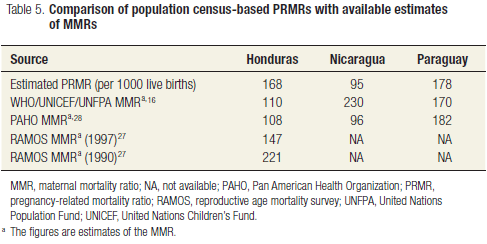
The comparison of our results for Honduras with the two national RAMOS is the most interesting.26 Such surveys are often regarded as the gold standard, since they attempt to identify every death of a woman of reproductive age in a given reference period and to ascertain whether the death was maternal. As noted above, the proportions of pregnancy-related deaths from the two surveys are consistent with data from the census. However, the census estimate of the PRMR for 2001 (168) is somewhat higher than the 1997 PRMR estimate (147) and substantially higher than the 1997 MMR estimate (108). A comparison of the census and survey estimates indicates that the PRMRs differ primarily because our analysis yielded a substantially lower estimate for the number of births (170 889) than the 1997 survey (190 887); the numbers of pregnancy-related deaths are virtually identical. The estimated MMRs differ by a larger amount because we assume that the PRMR approximates the MMR, whereas in the 1997 RAMOS, less than 75% of pregnancy-related deaths were identified as maternal (a figure substantially and surprisingly lower than that from the 1990 RAMOS only 7 years earlier).
Our estimates are thus quite similar to other estimates for Paraguay, higher than other estimates for Honduras (at least in terms of MMR), and substantially lower than other estimates for Nicaragua. It may surprise health experts in Latin America that Nicaragua should have lower maternal and overall female mortality than Honduras and Paraguay. However, the diagnostic exercises carried out in our analysis did not suggest the presence of special problems in Nicaragua, so in the absence of gold standard estimates, we cannot dismiss the estimates obtained for that country.
Conclusion
Our analysis suggests that in countries where civil registration data are incomplete, it is feasible to obtain an approximate indicator of maternal mortality with supplementary questions about deaths of women of reproductive age and about the timing of the deaths relative to pregnancy. Although data sources such as the Demographic and Health Surveys have improved our knowledge of process indicators related to maternal mortality, such as institutional deliveries or skilled attendant at delivery, the estimates of maternal mortality have been disappointing.29,30 Census data may also provide a unique opportunity to study regional or socioeconomic differentials in maternal mortality, an advantage not offered by estimates from sibling-based methods such as those used by the Demographic and Health Surveys. It is clear, however, that additional validation of this method (for example, in demographic surveillance sites) could lead to increased accuracy of results through improved formulation of the questions. 
Acknowledgements
The authors acknowledge the contribution of Maria Perez-Patron to data preparation and organization of the analysis workshop that resulted in this paper.
Funding: This work was undertaken as part of an international research programme, the Initiative for Maternal Mortality Programme Assessment (IMMPACT, http://www.abdn.ac.uk/immpact), which is funded by the Bill & Melinda Gates Foundation, the Department for International Development, the European Commission and USAID. The funders have no responsibility for the information provided or views expressed in this paper.
Competing interests: None declared.
References
1. Resolution A/RES. 55/2. United Nations Millennium Declaration. In: Fifty-fifth United Nations General Assembly, New York, 18 September 2000. New York, NY: UN; 2000 (A/RES/55/2).
2. Graham W, Brass W, Snow R. Estimating maternal mortality: the sisterhood method. Stud Fam Plann 1989;20:125-35. doi:10.2307/1966567 PMID:2734809
3. AbouZahr C. Maternal mortality overview [chapter 3]. In: Murray CJM, Lopez AD. Eds. Health dimensions of sex and reproduction. Cambridge, MA: Harvard University School of Public Health; 1998. ISBN 0-674-38335-4.
4. Hill K, El Arifeen S, Koenig M, Jamil K, Raggers H. How should we be estimating maternal mortality in the developing world? Bull World Health Organ 2006;84:173-80. doi:10.2471/BLT.05.027714 PMID:16583075
5. United Nations. Principles and recommendations for population and housing censuses, revision 2. New York, NY: UN; 2007 (Series M. No. 67/Rev.2).
6. Brass W. Methods for estimating fertility and mortality from limited and defective data. Chapel Hill, NC: University of North Carolina; 1975.
7. Bennett NG, Horiuchi S. Estimating the completeness of death registration in a closed population. Popul Index 1981;47:207-21. doi:10.2307/2736447
8. Hill K. Estimating census and death registration completeness. Asian Pac Cens Forum 1987;1:8-13,23-24.
9. Preston SH, Coale AJ, Trussell TJ, Weinstein M. Estimating the completeness of reporting of adult deaths in populations that are approximately stable. Popul Stud 1980;46:179-202.
10. Stanton C, Hobcraft J, Hill K, Naghavi M, Munene F, Mapeta WT, et al. Every death counts: measuring maternal mortality via a census. Bull World Health Organ 2001;79:657-64. PMID:11477969
11. International statistical classification of diseases and related health problems, tenth revision. Geneva: World Health Organization; 1992.
12. Stecklov G. Maternal mortality estimation: separating pregnancy-related and non-pregnancy related risks. Stud Fam Plann 1995;26:33-8. doi:10.2307/2138049 PMID:7785066
13. Shahidullah M. The sisterhood method of estimating maternal mortality: The Matlab experience. Stud Fam Plann 1995;26:101-6. doi:10.2307/2137935 PMID:7618193
14. Rutenberg N, Sullivan JM. Direct and indirect estimates of maternal mortality from the sisterhood method. Washington, DC: IRD/Macro International, Inc.: 1991.
15. Revised 1990 estimates of maternal mortality: a new approach by WHO and UNICEF. Geneva: World Health Organization and United Nations Children's Fund; 1996.
16. Maternal mortality in 1995: estimates developed by WHO, UNICEF, UNFPA. Geneva: World Health Organization, United Nations Children's Fund and United Nations Population Fund; 2001.
17. Maternal mortality in 2000: estimates developed by WHO, UNICEF and UNFPA. Geneva: World Health Organization, United Nations Children's Fund and United Nations Population Fund; 2004.
18. Hill K, Thomas KE, Abouzahr C, Walker N, Say L, Inoue M, et al. Estimates of maternal mortality worldwide between 1990 and 2005: an assessment of available data. Lancet 2007;370:1311-9. doi:10.1016/S0140-6736(07)61572-4 PMID:17933645
19. Preston SH, Heuveline P, Guillot M. Demography. Oxford: Blackwell; 2001.
20. Hill K, Barker B, Vos T. Excess indigenous mortality: are indigenous Australians more severely disadvantaged than other indigenous populations? Int J Epidemiol 2007;36:580-9. doi:10.1093/ije/dym011 PMID:17405802
21. Zlotnik H, Hill K. The use of hypothetical cohorts in estimating demographic parameters under conditions of changing fertility and mortality. Demography 1981;18:103-22. doi:10.2307/2061052 PMID:7202783
22. United Nations. Manual X: indirect techniques for demographic estimation. New York, NY: UN; 1983.
23. Comisión Económica para América Latina y el Caribe. Tablas de mortalidad, 1950-2025, América Latina. Bol Demogr No. 67 (CELADE) 2001;67:158,174,190.
24. Centers for Disease Control and Prevention. Pregnancy-related deaths among Hispanic, Asian/Pacific Islander, and American Indian/Alaska native women - United States, 1991-1997. MMWR 2001;50:361-4. PMID:11465911
25. National Institute of Population Research and Training, ORC Macro, Johns Hopkins University and ICDDR.B. Bangladesh Maternal Health Services and Maternal Mortality Survey 2001. Dhaka and Calverton, MD: NIPORT, ORC Macro, Johns Hopkins University and ICDDR.B; 2003.
26. Thomas K, Hill K. Evaluating the performance of death distribution methods or estimating death registration completeness: applications to data from high income countries. Paper presented to: Annual Meetings of the Population Association of America, New York, 29-31 March 2007.
27. Melendez JH, Ochoa Vasquez JC, Villanueva Y. Investigación sobre mortalidad materna y de mujeres en edad reproductiva en Honduras. Tegucigalpa: Secretaría de Salud Pública; 1999.
28. Pan American Health Organization. Gender, health, and development in the Americas, basic indicators 2005. Washington, DC: PAHO; 2007.
29. Stanton C, Abderrahim N, Hill K. An assessment of DHS maternal mortality indicators. Stud Fam Plann 2000;31:111-23. doi:10.1111/j.1728-4465.2000.00111.x PMID:10907277
30. Gakidou E, Hogan M, Lopez AD. Adult mortality: time for a reappraisal. Int J Epidemiol 2004;33:710-7. doi:10.1093/ije/dyh099 PMID:15282220
(Submitted: 19 February 2008 - Revised version received: 12 September 2008 - Accepted: 15 September 2008 - Published online: 13 February 2009)
*Correspondence to Kenneth Hill (e-mail: kenneth_hill@harvard.edu).
